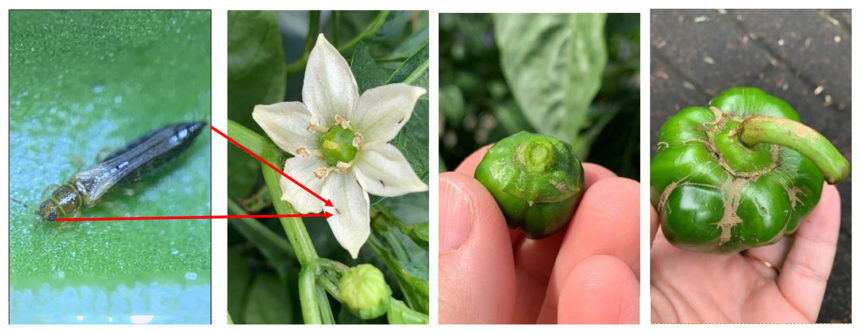
By Clint Thompson
The earlier the better when detecting and managing Thrips (T.) parvispinus in vegetable crops. The longer South Florida growers wait to scout, the more susceptible their crops become, especially peppers.
Anna Meszaros, University of Florida Institute of Food and Agricultural Sciences (UF/IFAS) Extension commercial horticulture agent in West Palm Beach, Florida, updated pepper growers about the insect during the Florida Citrus Show last month in Fort Pierce, Florida. She emphasized early detection.
“Management starts with proper identification and scouting. For these thrips, I think the most important thing is to catch it early. Early detection is crucial,” Meszaros said. “Growers need to check plants as soon as they get them from the greenhouse and as soon as they plant them in the field. Keep monitoring it. We don’t have a threshold, but we know that one or two thrips can cause substantial damage to the small plants. That’s why they need to catch it early.”
Insect Background
According to the University of Florida Institute of Food and Agricultural Sciences, Thrips parvispinus, which was originally discovered in Florida in 2020, is a pest that can damage vegetable, ornamental and fruit crops.
Insecticide applications are also more effective when done early in the season.
“Also, when the plants are smaller, insecticide coverage is going to be better. If the plants are getting bigger and bigger, management becomes challenging because the thrips like to hide everywhere in the plant,” she added. “Early detection is the most important thing. Don’t hesitate to apply the proper insecticide on it.”
Meszaros and Julien Beuzelin, UF/IFAS entomologist, updated Florida Citrus Show attendees on Thrips (T.) parvispinus management in peppers. It is vital that producers remain vigilant in their scouting procedures, which should start right after planting. Pepper producers should monitor the axillary and terminal buds and scout the lower portion of the canopy looking for injury on the underside of the leaves and for adults and larvae.










